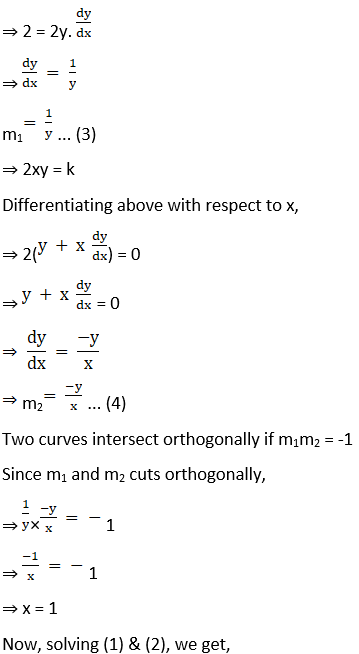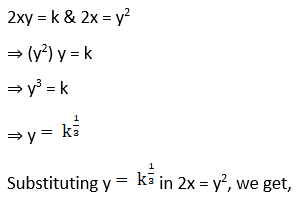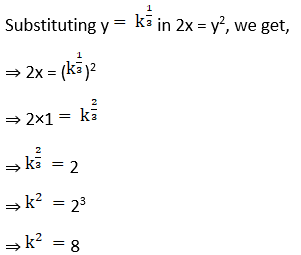Chapter 16 TANGENTS AND NORMALS
Class 12th Maths R D Sharma Solution
Access answers to Maths RD Sharma Solutions For Class 12 Chapter 16 – Tangents and Normals
Exercise 16.1 Page No: 16.10
1. Find the Slopes of the tangent and the normal to the following curves at the indicated points:

Solution:
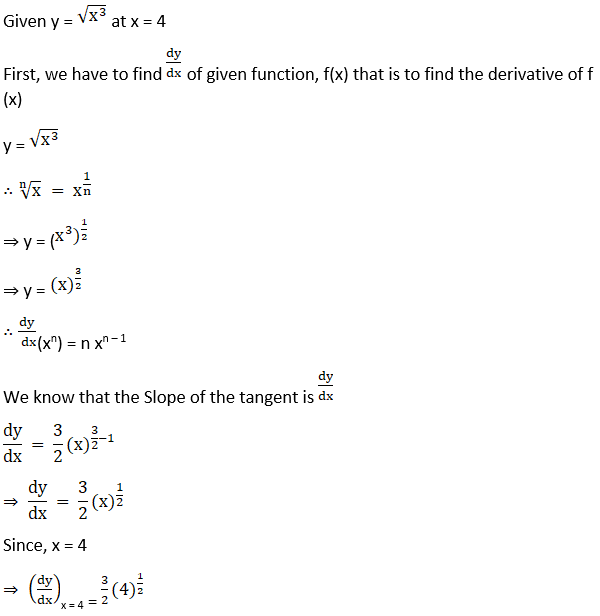

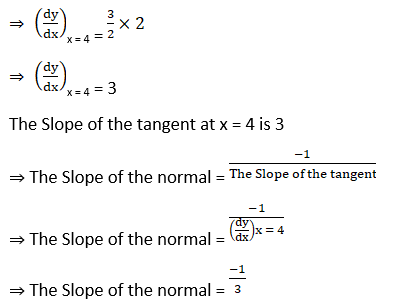
(ii) y = √x at x = 9
Solution:
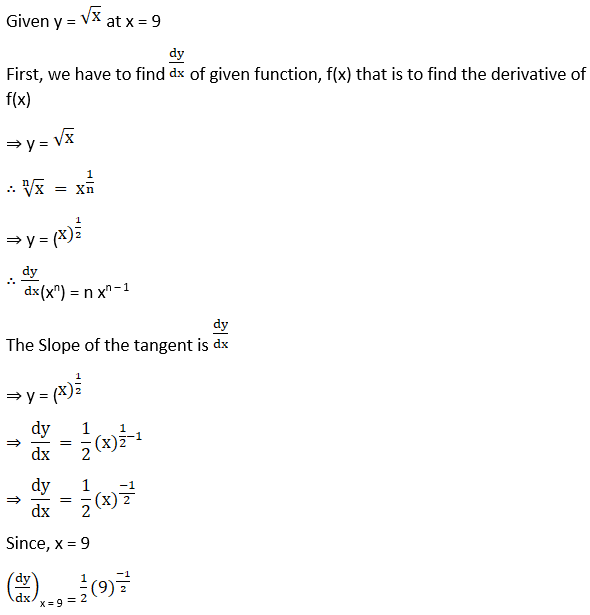
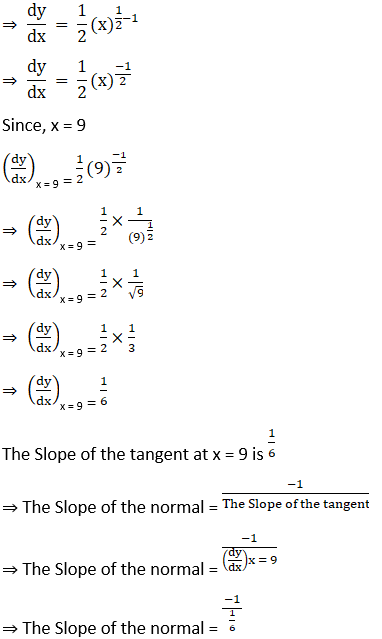
⇒ The Slope of the normal = – 6
(iii) y = x3 – x at x = 2
Solution:

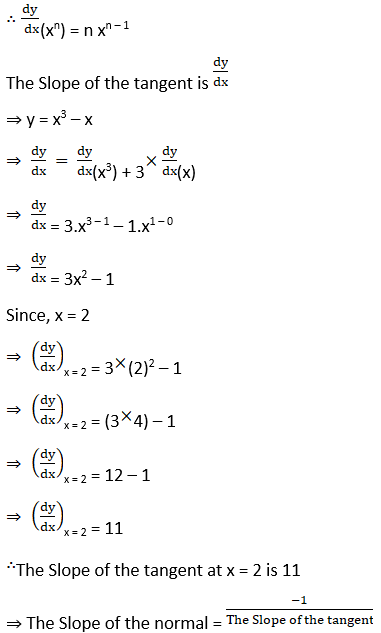
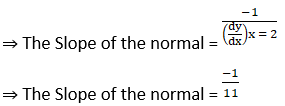
(iv) y = 2x2 + 3 sin x at x = 0
Solution:
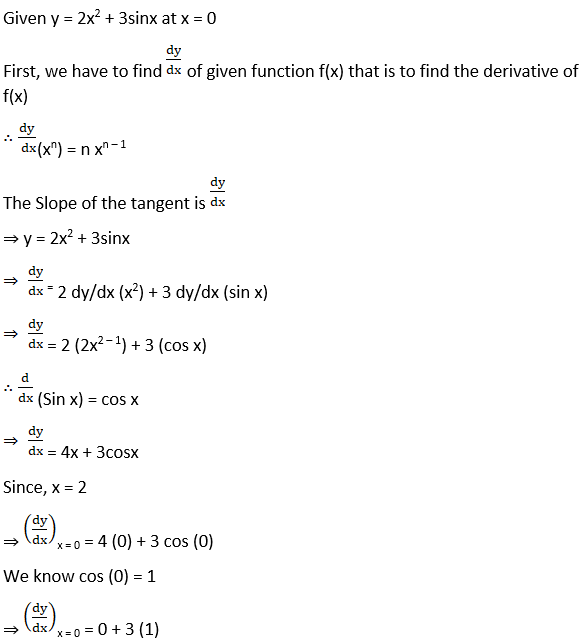
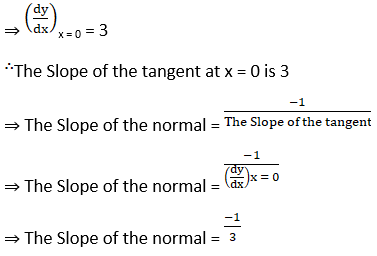

(v) x = a (θ – sin θ), y = a (1 + cos θ) at θ = -π /2
Solution:
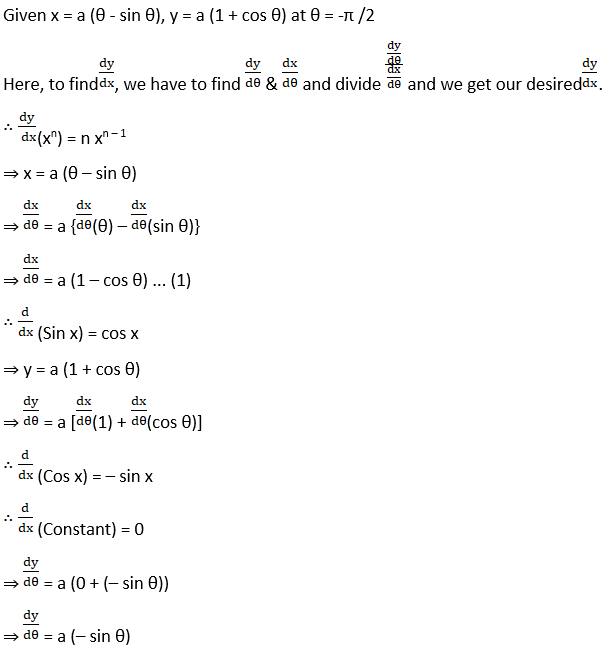
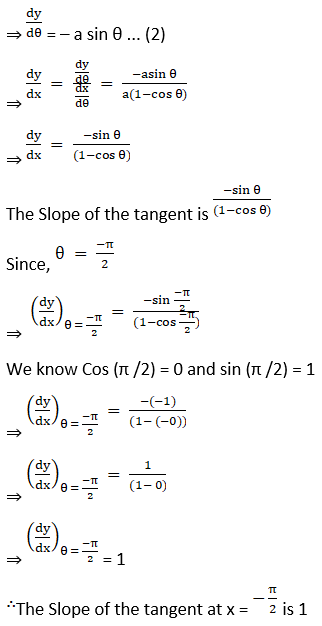
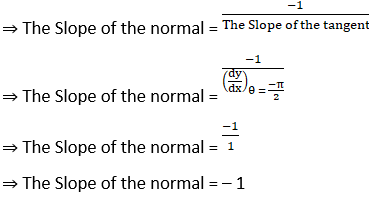
(vi) x = a cos3 θ, y = a sin3 θ at θ = π /4
Solution:
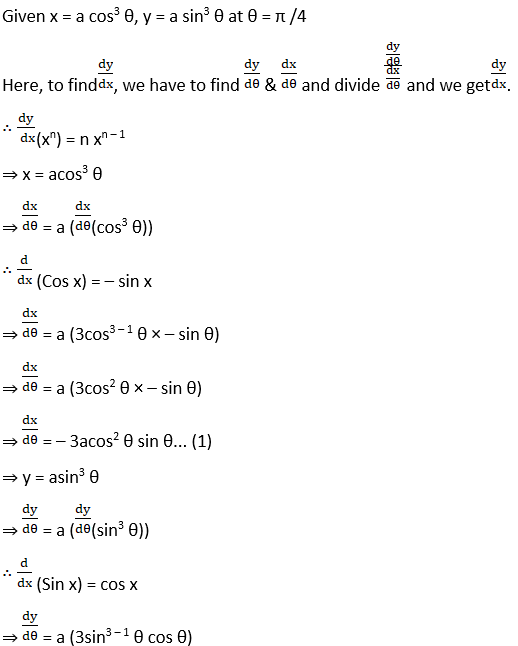
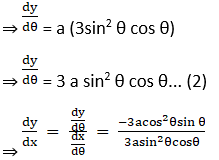
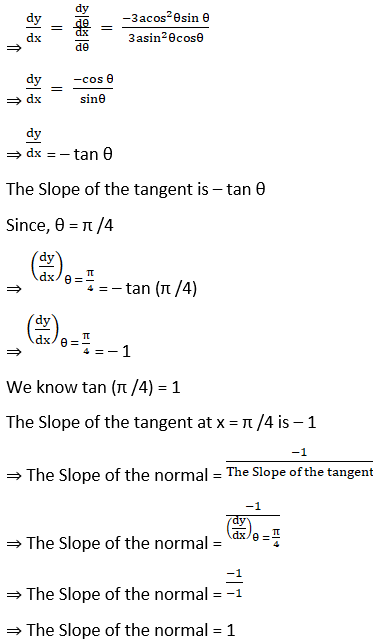
(vii) x = a (θ – sin θ), y = a (1 – cos θ) at θ = π /2
Solution:

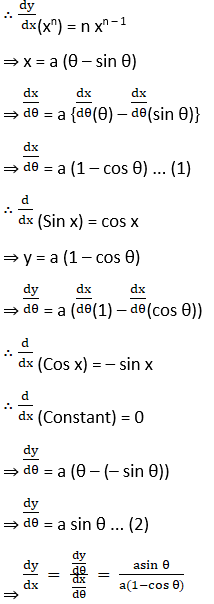
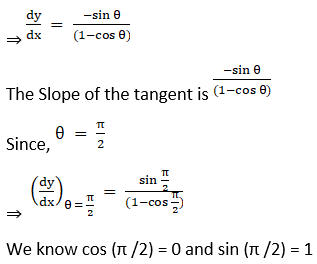
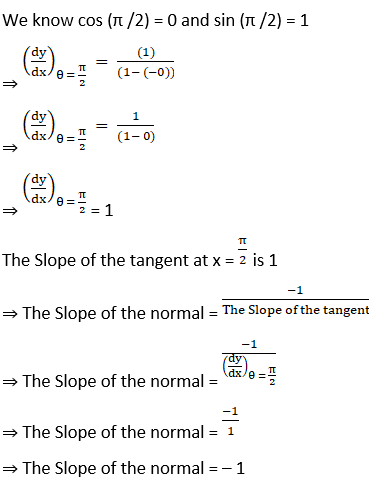
(viii) y = (sin 2x + cot x + 2)2 at x = π /2
Solution:
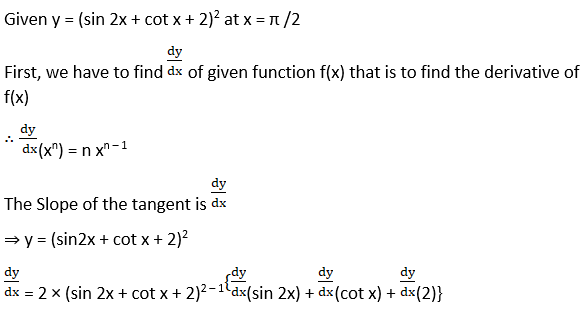
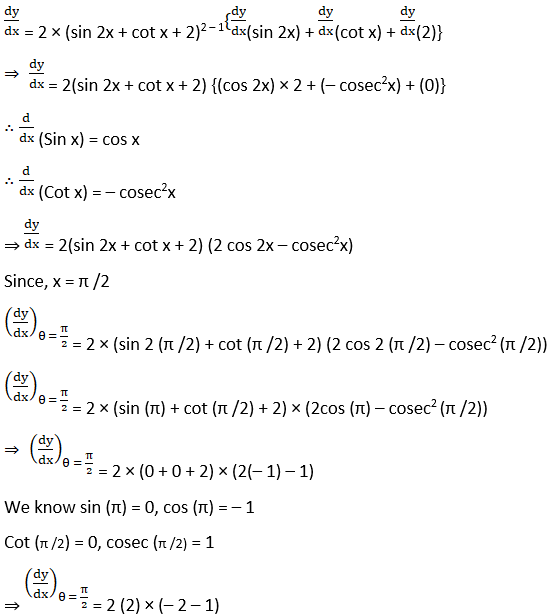
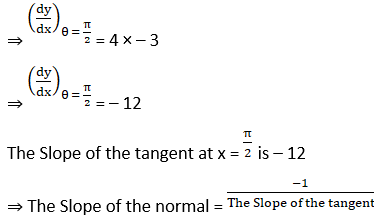
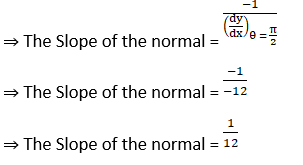
(ix) x2 + 3y + y2 = 5 at (1, 1)
Solution:
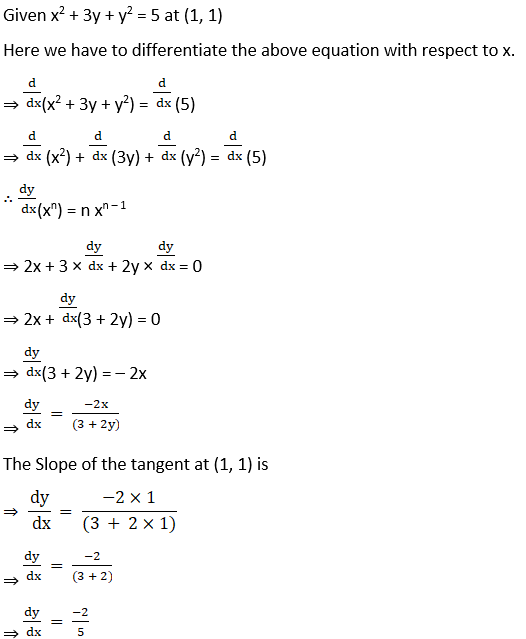
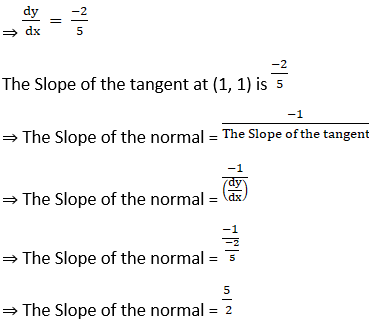
(x) x y = 6 at (1, 6)
Solution:
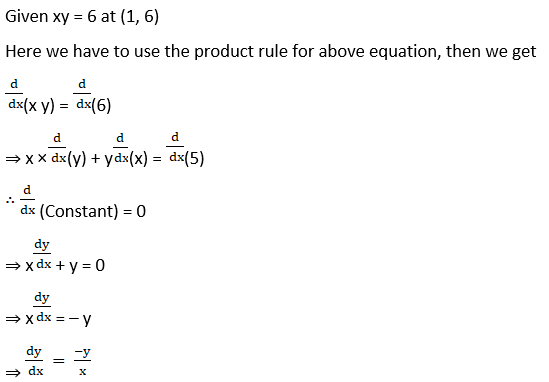
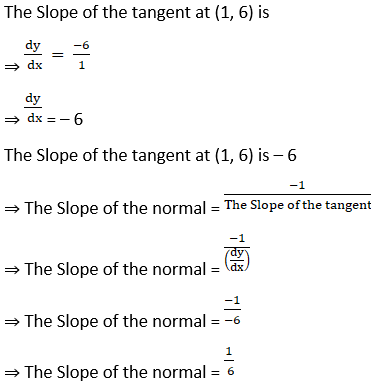
2. Find the values of a and b if the Slope of the tangent to the curve x y + a x + by = 2 at (1, 1) is 2.
Solution:
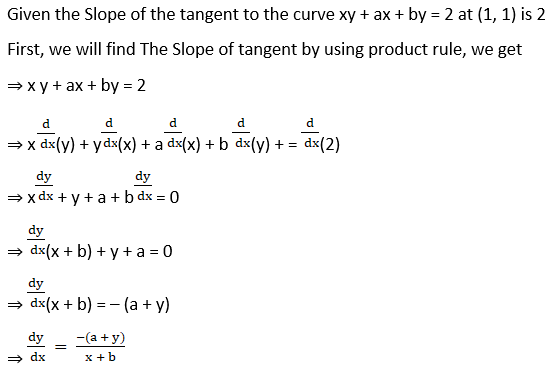
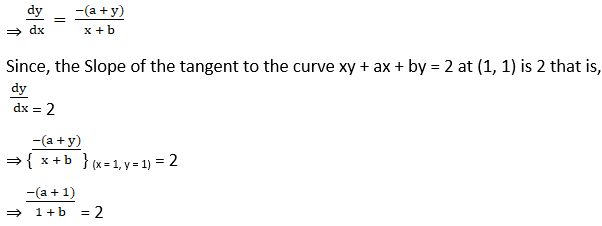
⇒ – a – 1 = 2(1 + b)
⇒ – a – 1 = 2 + 2b
⇒ a + 2b = – 3 … (1)
Also, the point (1, 1) lies on the curve xy + ax + by = 2, we have
1 × 1 + a × 1 + b × 1 = 2
⇒ 1 + a + b = 2
⇒ a + b = 1 … (2)
From (1) & (2), we get b = -4
Substitute b = – 4 in a + b = 1
a – 4 = 1
⇒ a = 5
So the value of a = 5 & b = – 4
3. If the tangent to the curve y = x3 + a x + b at (1, – 6) is parallel to the line x – y + 5 = 0, find a and b
Solution:
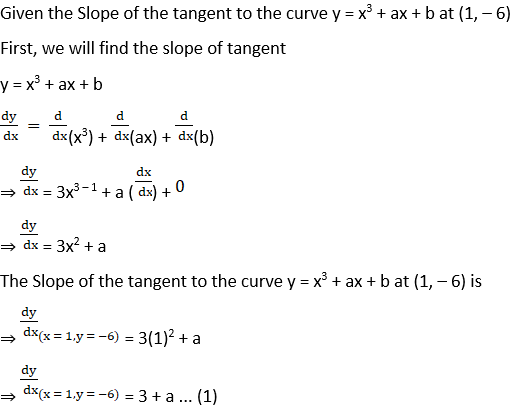
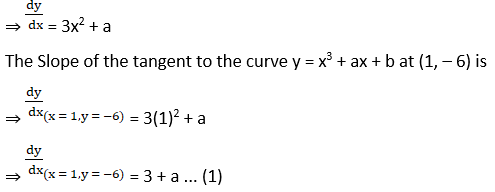
The given line is x – y + 5 = 0
y = x + 5 is the form of equation of a straight line y = mx + c, where m is the Slope of the line.
So the slope of the line is y = 1 × x + 5
So the Slope is 1. … (2)
Also the point (1, – 6) lie on the tangent, so
x = 1 & y = – 6 satisfies the equation, y = x3 + ax + b
– 6 = 13 + a × 1 + b
⇒ – 6 = 1 + a + b
⇒ a + b = – 7 … (3)
Since, the tangent is parallel to the line, from (1) & (2)
Hence, 3 + a = 1
⇒ a = – 2
From (3)
a + b = – 7
⇒ – 2 + b = – 7
⇒ b = – 5
So the value is a = – 2 & b = – 5
4. Find a point on the curve y = x3 – 3x where the tangent is parallel to the chord joining (1, – 2) and (2, 2).
Solution:
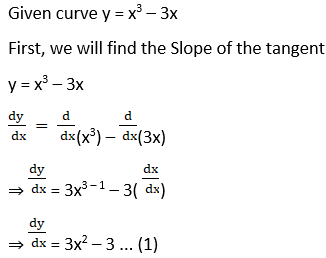
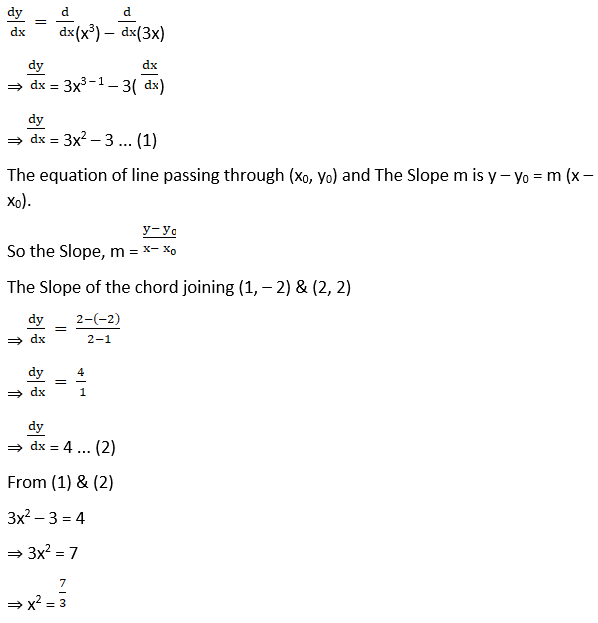
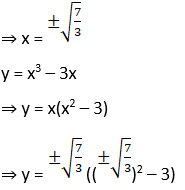
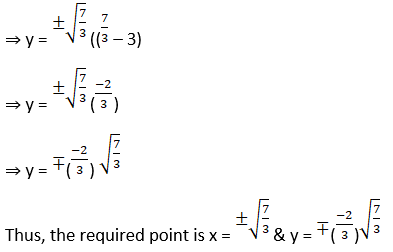
5. Find a point on the curve y = x3 – 2x2 – 2x at which the tangent lines are parallel to the line y = 2x – 3.
Solution:
Given the curve y = x3 – 2x2 – 2x and a line y = 2x – 3
First, we will find the slope of tangent
y = x3 – 2x2 – 2x
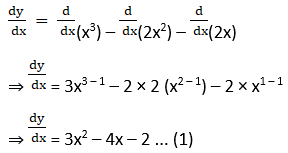
y = 2x – 3 is the form of equation of a straight line y = mx + c, where m is the Slope of the line.
So the slope of the line is y = 2 × (x) – 3
Thus, the Slope = 2. … (2)
From (1) & (2)
⇒ 3x2 – 4x – 2 = 2
⇒ 3x2 – 4x = 4
⇒ 3x2 – 4x – 4 = 0
We will use factorization method to solve the above Quadratic equation.
⇒ 3x2 – 6x + 2x – 4 = 0
⇒ 3 x (x – 2) + 2 (x – 2) = 0
⇒ (x – 2) (3x + 2) = 0
⇒ (x – 2) = 0 & (3x + 2) = 0
⇒ x = 2 or
x = -2/3
Substitute x = 2 & x = -2/3 in y = x3 – 2x2 – 2x
When x = 2
⇒ y = (2)3 – 2 × (2)2 – 2 × (2)
⇒ y = 8 – (2 × 4) – 4
⇒ y = 8 – 8 – 4
⇒ y = – 4
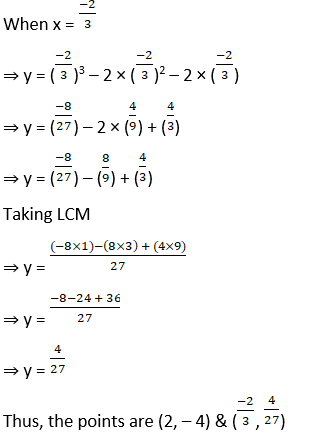
6. Find a point on the curve y2 = 2x3 at which the Slope of the tangent is 3
Solution:
Given the curve y2 = 2x3 and the Slope of tangent is 3
y2 = 2x3
Differentiating the above with respect to x
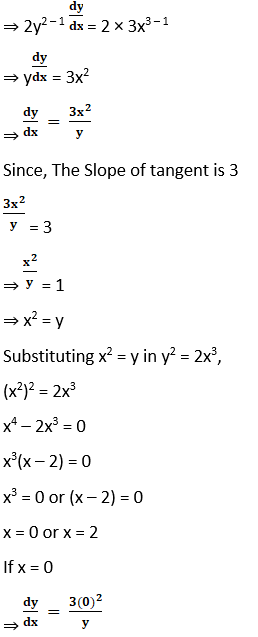
dy/dx = 0 which is not possible.
So we take x = 2 and substitute it in y2 = 2x3, we get
y2 = 2(2)3
y2 = 2 × 8
y2 = 16
y = 4
Thus, the required point is (2, 4)
7. Find a point on the curve x y + 4 = 0 at which the tangents are inclined at an angle of 45o with the x–axis.
Solution:
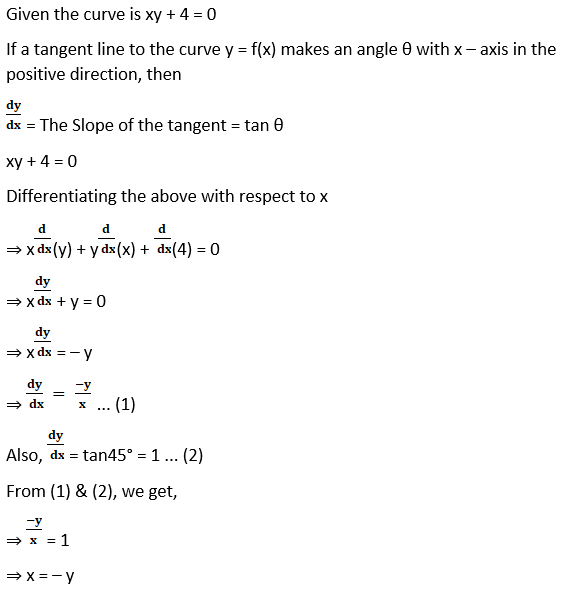
Substitute in xy + 4 = 0, we get
⇒ x (– x) + 4 = 0
⇒ – x2 + 4 = 0
⇒ x2 = 4
⇒ x = 2
2
So when x = 2, y = – 2
And when x = – 2, y = 2
Thus, the points are (2, – 2) & (– 2, 2)
8. Find a point on the curve y = x2 where the Slope of the tangent is equal to the x – coordinate of the point.
Solution:
Given the curve is y = x2
y = x2
Differentiating the above with respect to x
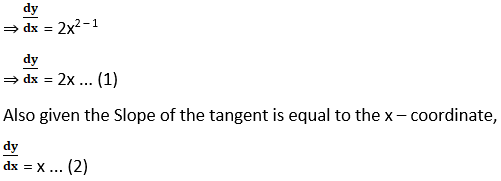
From (1) & (2), we get,
2x = x
⇒ x = 0.
Substituting this in y = x2, we get,
y = 02
⇒ y = 0
Thus, the required point is (0, 0)
9. At what point on the circle x2 + y2 – 2x – 4y + 1 = 0, the tangent is parallel to x – axis.
Solution:
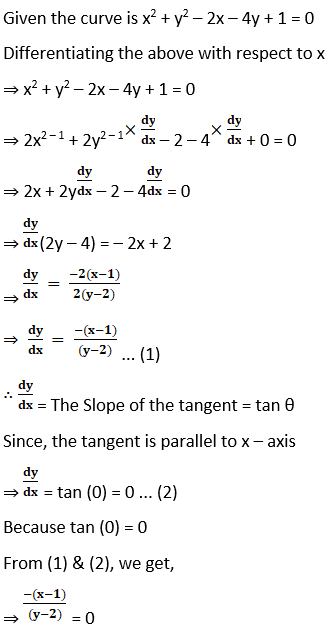
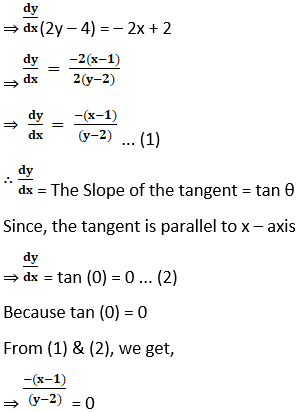
⇒ – (x – 1) = 0
⇒ x = 1
Substituting x = 1 in x2 + y2 – 2x – 4y + 1 = 0, we get,
⇒ 12 + y2 – 2(1) – 4y + 1 = 0
⇒ 1 – y2 – 2 – 4y + 1 = 0
⇒ y2 – 4y = 0
⇒ y (y – 4) = 0
⇒ y = 0 and y = 4
Thus, the required point is (1, 0) and (1, 4)
10. At what point of the curve y = x2 does the tangent make an angle of 45o with the x–axis?
Solution:
Given the curve is y = x2
Differentiating the above with respect to x
⇒ y = x2
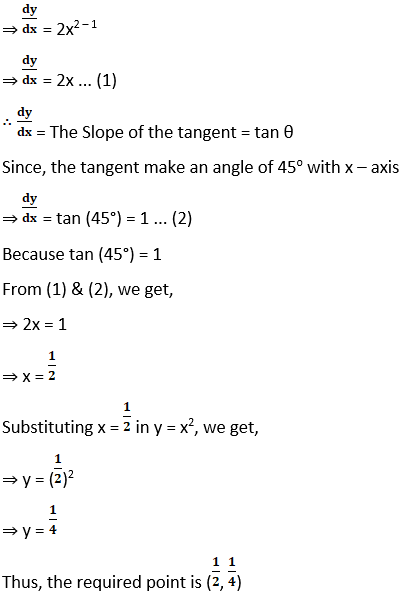
Exercise 16.2 Page No: 15.27
1. Find the equation of the tangent to the curve √x + √y = a, at the point (a2/4, a2/4).
Solution:
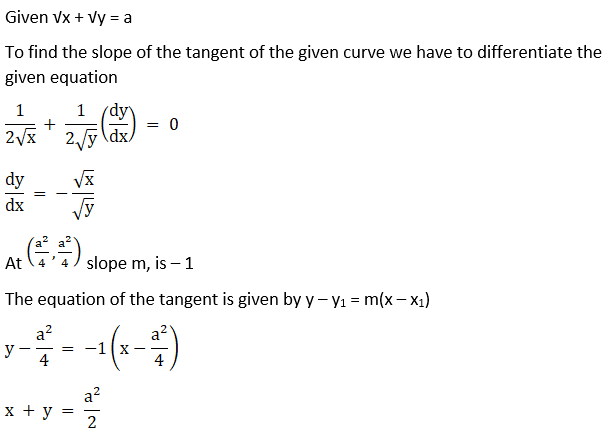
2. Find the equation of the normal to y = 2x3 – x2 + 3 at (1, 4).
Solution:
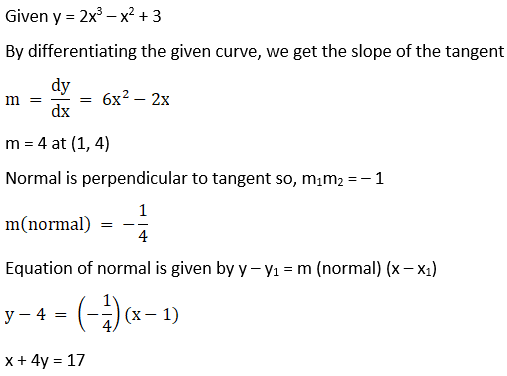
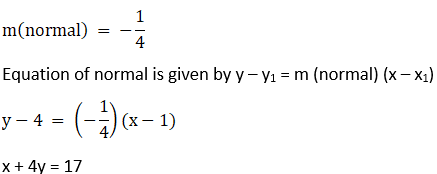
3. Find the equation of the tangent and the normal to the following curves at the indicated points:
(i) y = x4 – 6x3 + 13x2 – 10x + 5 at (0, 5)
Solution:
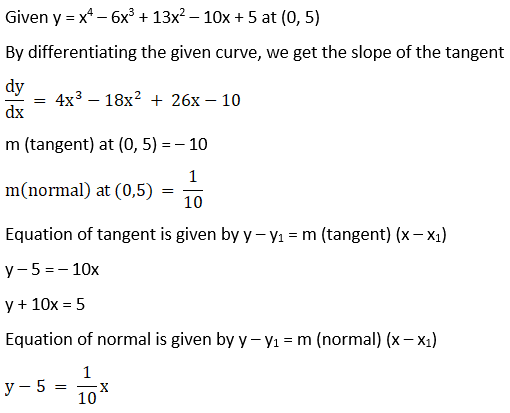
(ii) y = x4 – 6x3 + 13x2 – 10x + 5 at x = 1 y = 3
Solution:
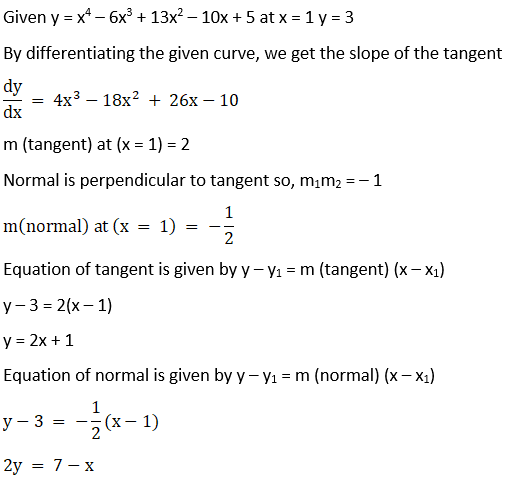
(iii) y = x2 at (0, 0)
Solution:
Given y = x2 at (0, 0)
By differentiating the given curve, we get the slope of the tangent

m (tangent) at (x = 0) = 0
Normal is perpendicular to tangent so, m1m2 = – 1

We can see that the slope of normal is not defined
Equation of tangent is given by y – y1 = m (tangent) (x – x1)
y = 0
Equation of normal is given by y – y1 = m (normal) (x – x1)
x = 0
(iv) y = 2x2 – 3x – 1 at (1, – 2)
Solution:
Given y = 2x2 – 3x – 1 at (1, – 2)
By differentiating the given curve, we get the slope of the tangent

m (tangent) at (1, – 2) = 1
Normal is perpendicular to tangent so, m1m2 = – 1
m (normal) at (1, – 2) = – 1
Equation of tangent is given by y – y1 = m (tangent) (x – x1)
y + 2 = 1(x – 1)
y = x – 3
Equation of normal is given by y – y1 = m (normal) (x – x1)
y + 2 = – 1(x – 1)
y + x + 1 = 0

Solution:
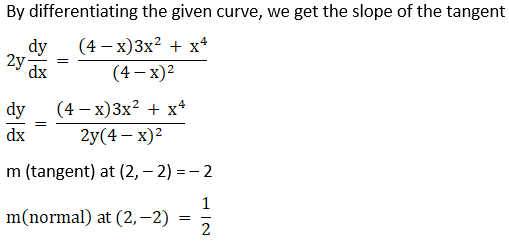
Equation of tangent is given by y – y1 = m (tangent) (x – x1)
y + 2 = – 2(x – 2)
y + 2x = 2
Equation of normal is given by y – y1 = m (normal) (x – x1)

2y + 4 = x – 2
2y – x + 6 = 0
4. Find the equation of the tangent to the curve x = θ + sin θ, y = 1 + cos θ at θ = π/4.
Solution:
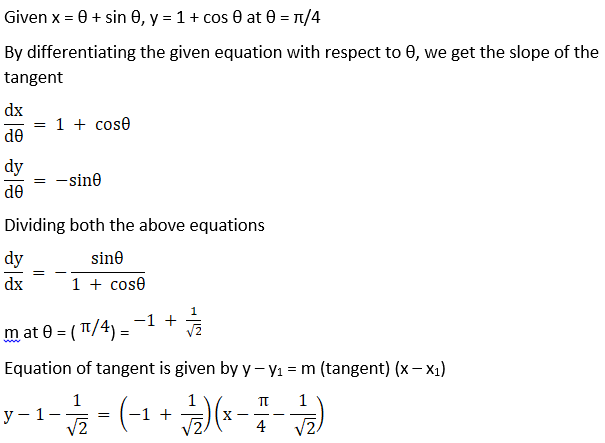
5. Find the equation of the tangent and the normal to the following curves at the indicated points:
(i) x = θ + sin θ, y = 1 + cos θ at θ = π/2
Solution:
Given x = θ + sin θ, y = 1 + cos θ at θ = π/2
By differentiating the given equation with respect to θ, we get the slope of the tangent
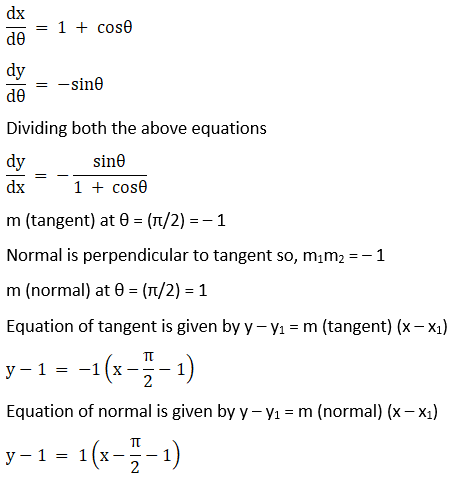

Solution:
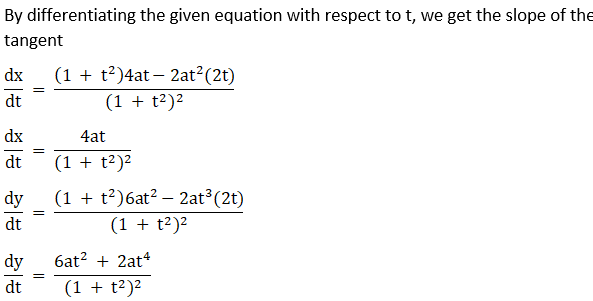
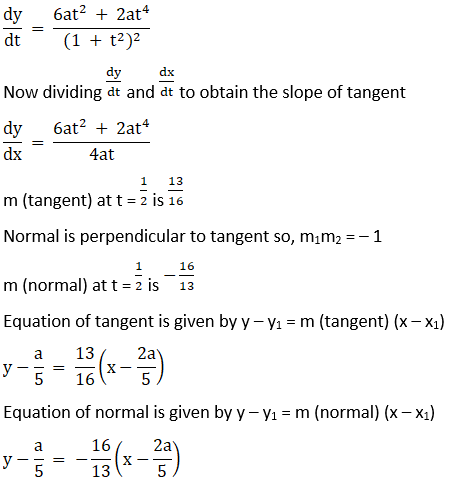
(iii) x = at2, y = 2at at t = 1.
Solution:
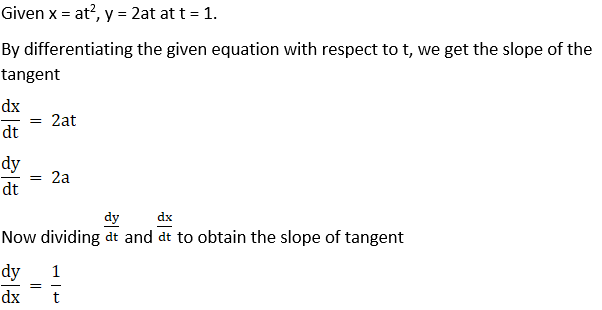
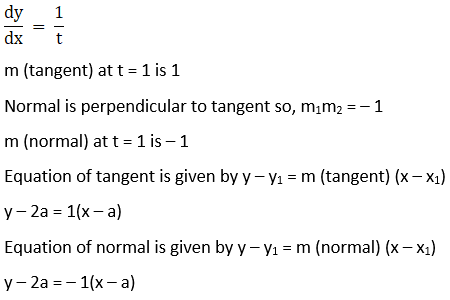
(iv) x = a sec t, y = b tan t at t.
Solution:
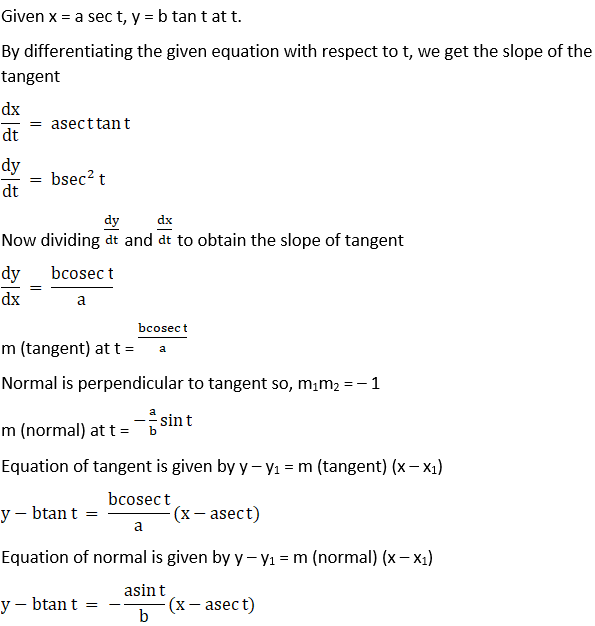
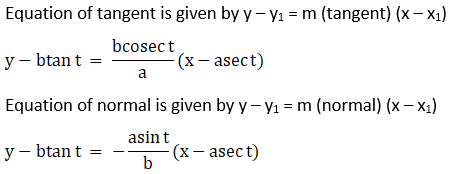
(v) x = a (θ + sin θ), y = a (1 – cos θ) at θ
Solution:
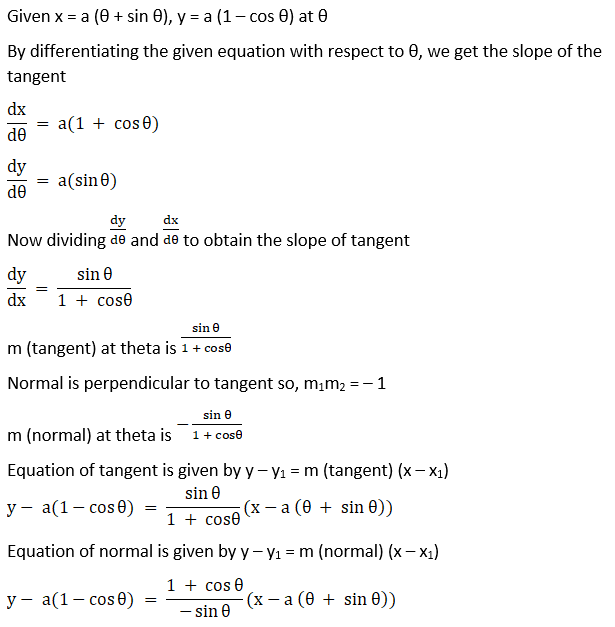

(vi) x = 3 cos θ – cos3 θ, y = 3 sin θ – sin3θ
Solution:
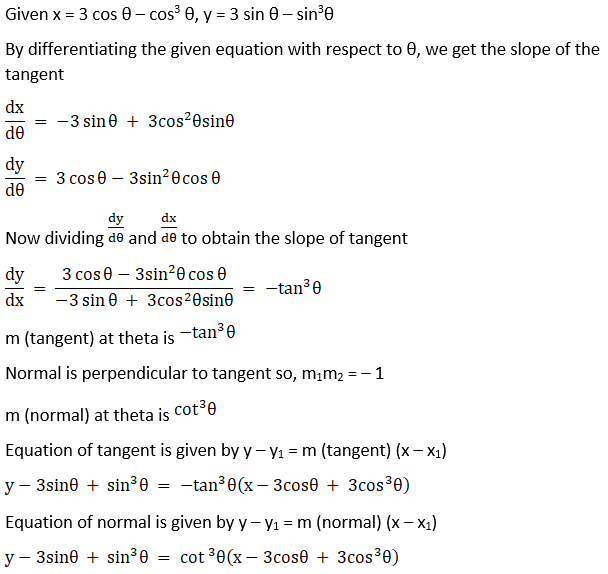
6. Find the equation of the normal to the curve x2 + 2y2 – 4x – 6y + 8 = 0 at the point whose abscissa is 2.
Solution:
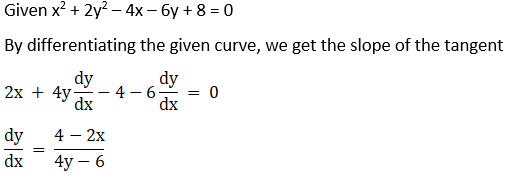
Finding y co – ordinate by substituting x in the given curve
2y2 – 6y + 4 = 0
y2 – 3y + 2 = 0
y = 2 or y = 1
m (tangent) at x = 2 is 0
Normal is perpendicular to tangent so, m1m2 = – 1
m (normal) at x = 2 is 1/0, which is undefined
Equation of normal is given by y – y1 = m (normal) (x – x1)
x = 2
7. Find the equation of the normal to the curve ay2 = x3 at the point (am2, am3).
Solution:
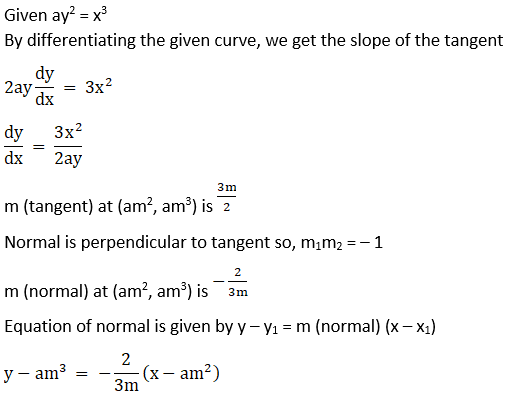

8. The equation of the tangent at (2, 3) on the curve y2 = ax3 + b is y = 4x – 5. Find the values of a and b.
Solution:
Given y2 = ax3 + b is y = 4x – 5
By differentiating the given curve, we get the slope of the tangent
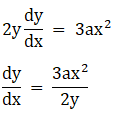
m (tangent) at (2, 3) = 2a
Equation of tangent is given by y – y1 = m (tangent) (x – x1)
Now comparing the slope of a tangent with the given equation
2a = 4
a = 2
Now (2, 3) lies on the curve, these points must satisfy
32 = 2 × 23 + b
b = – 7
9. Find the equation of the tangent line to the curve y = x2 + 4x – 16 which is parallel to the line 3x – y + 1 = 0.
Solution:
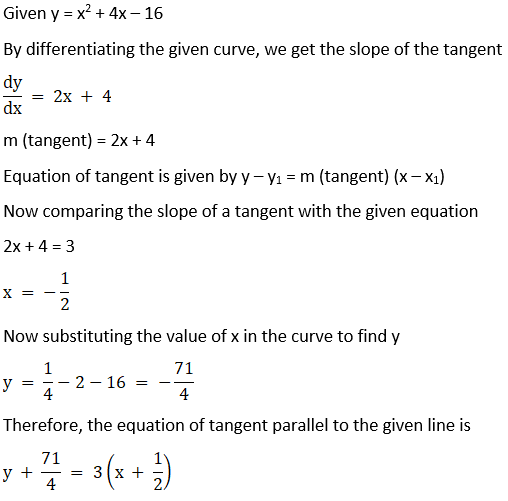
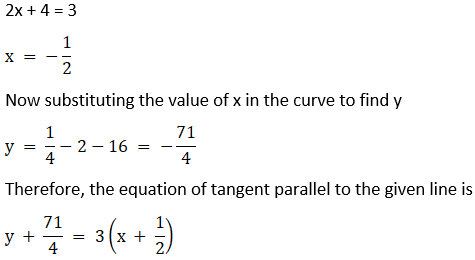
10. Find the equation of normal line to the curve y = x3 + 2x + 6 which is parallel to the line x + 14y + 4 = 0.
Solution:
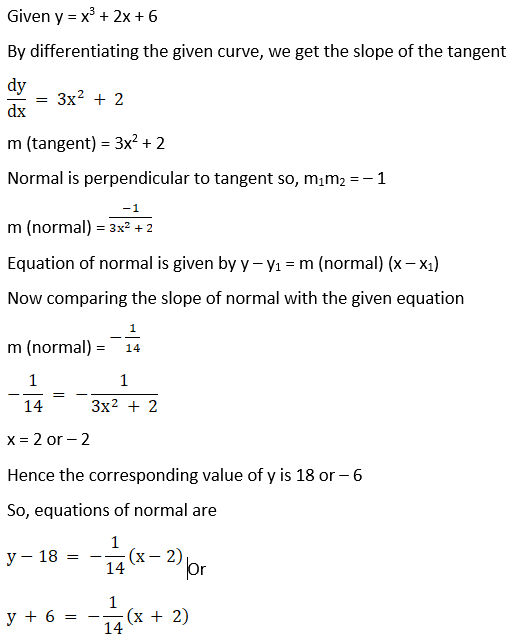
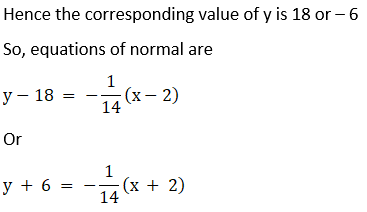
Exercise 16.3 Page No: 16.40
1. Find the angle to intersection of the following curves:
(i) y2 = x and x2 = y
Solution:
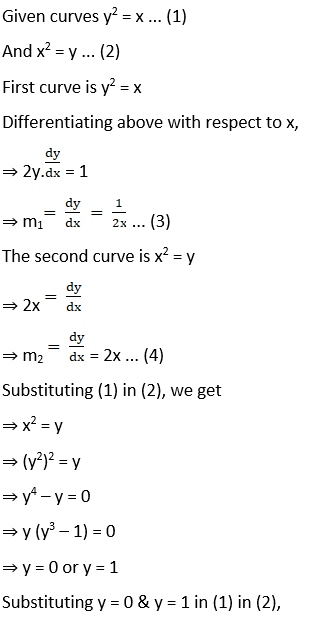
x = y2
When y = 0, x = 0
When y = 1, x = 1
Substituting above values for m1 & m2, we get,
When x = 0,
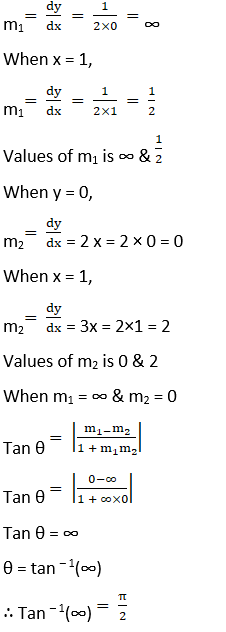
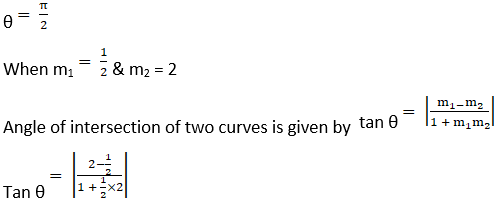
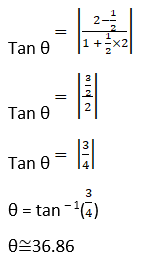
(ii) y = x2 and x2 + y2 = 20
Solution:
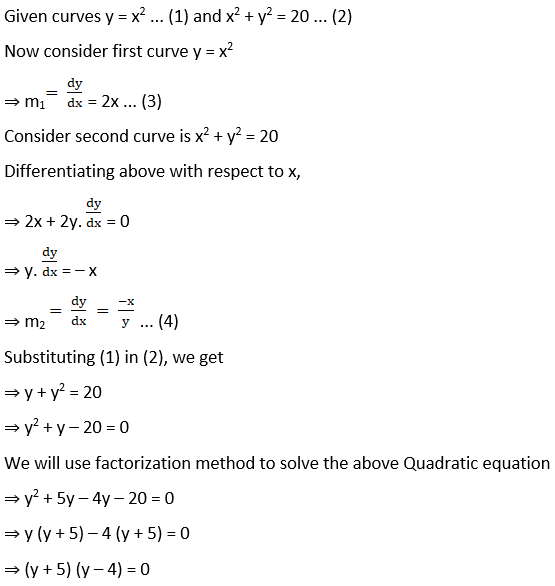
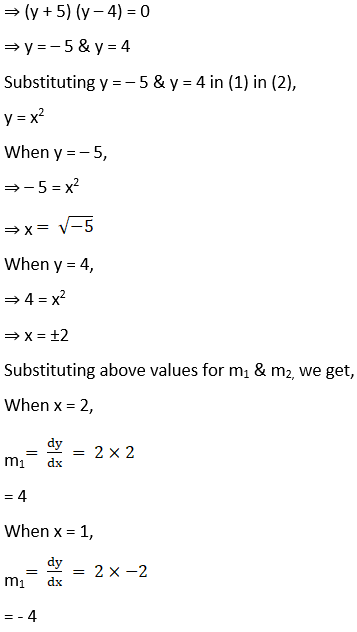
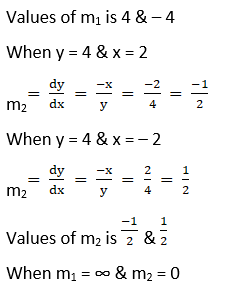
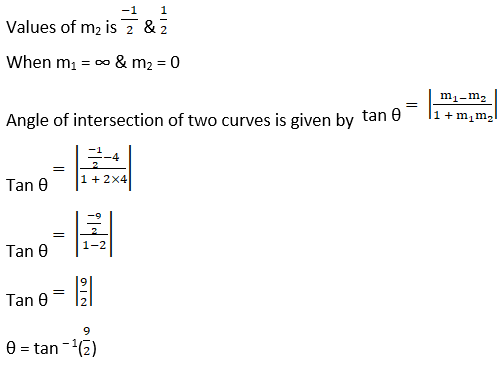
(iii) 2y2 = x3 and y2 = 32x
Solution:
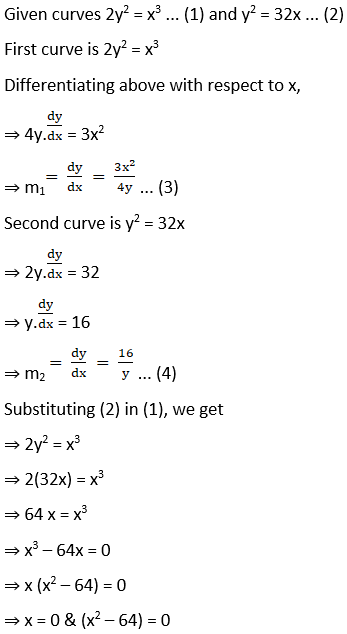
Substituting (2) in (1), we get
⇒ 2y2 = x3
⇒ 2(32x) = x3
⇒ 64 x = x3
⇒ x3 – 64x = 0
⇒ x (x2 – 64) = 0
⇒ x = 0 & (x2 – 64) = 0
⇒ x = 0 & ±8
Substituting x = 0 & x = ±8 in (1) in (2),
y2 = 32x
When x = 0, y = 0
When x = 8
⇒ y2 = 32 × 8
⇒ y2 = 256
⇒ y = ±16
Substituting above values for m1 & m2, we get,
When x = 0, y = 16

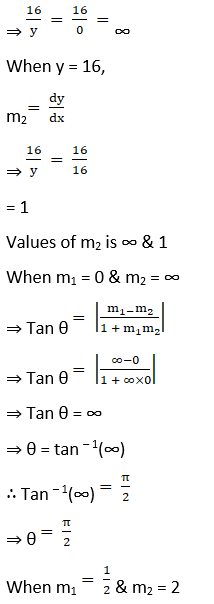
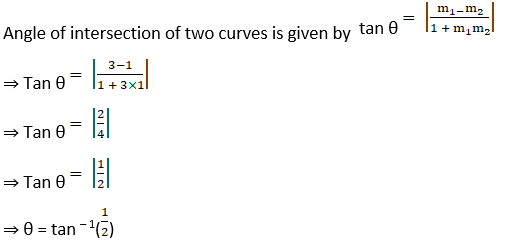
(iv) x2 + y2 – 4x – 1 = 0 and x2 + y2 – 2y – 9 = 0
Solution:
Given curves x2 + y2 – 4x – 1 = 0 … (1) and x2 + y2 – 2y – 9 = 0 … (2)
First curve is x2 + y2 – 4x – 1 = 0
⇒ x2 – 4x + 4 + y2 – 4 – 1 = 0
⇒ (x – 2)2 + y2 – 5 = 0
Now, Subtracting (2) from (1), we get
⇒ x2 + y2 – 4x – 1 – ( x2 + y2 – 2y – 9) = 0
⇒ x2 + y2 – 4x – 1 – x2 – y2 + 2y + 9 = 0
⇒ – 4x – 1 + 2y + 9 = 0
⇒ – 4x + 2y + 8 = 0
⇒ 2y = 4x – 8
⇒ y = 2x – 4
Substituting y = 2x – 4 in (3), we get,
⇒ (x – 2)2 + (2x – 4)2 – 5 = 0
⇒ (x – 2)2 + 4(x – 2)2 – 5 = 0
⇒ (x – 2)2(1 + 4) – 5 = 0
⇒ 5(x – 2)2 – 5 = 0
⇒ (x – 2)2 – 1 = 0
⇒ (x – 2)2 = 1
⇒ (x – 2) = ±1
⇒ x = 1 + 2 or x = – 1 + 2
⇒ x = 3 or x = 1
So, when x = 3
y = 2×3 – 4
⇒ y = 6 – 4 = 2
So, when x = 3
y = 2 × 1 – 4
⇒ y = 2 – 4 = – 2
The point of intersection of two curves are (3, 2) & (1, – 2)

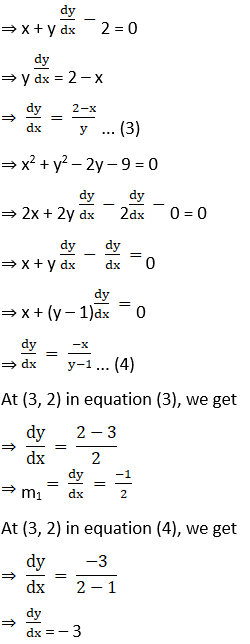
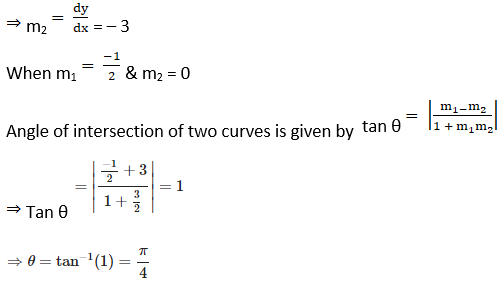
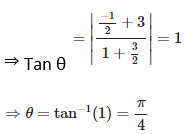

Solution:
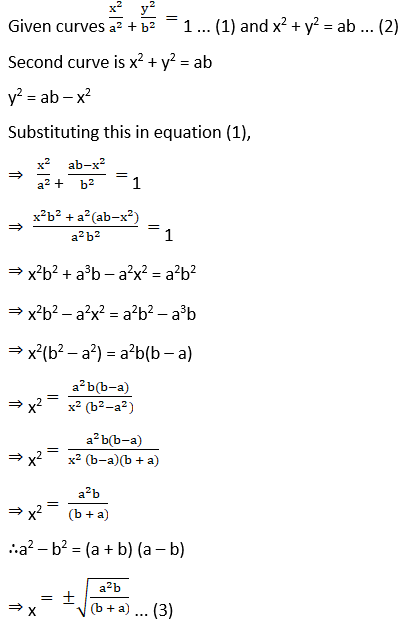
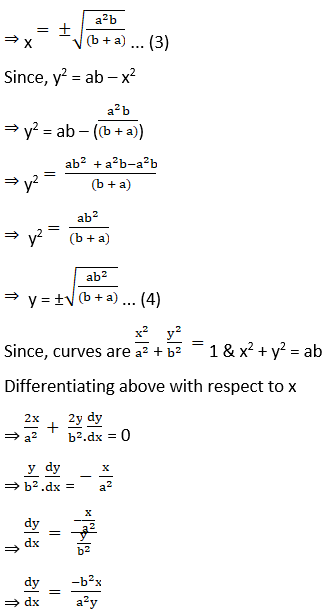
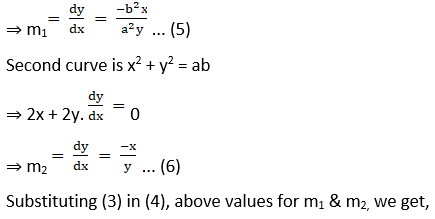
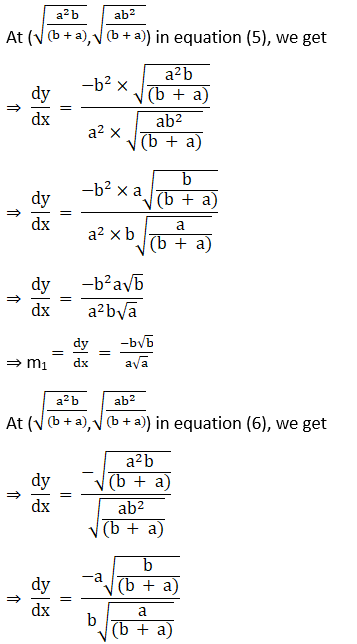
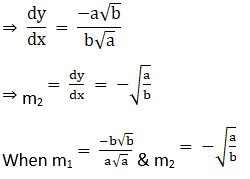
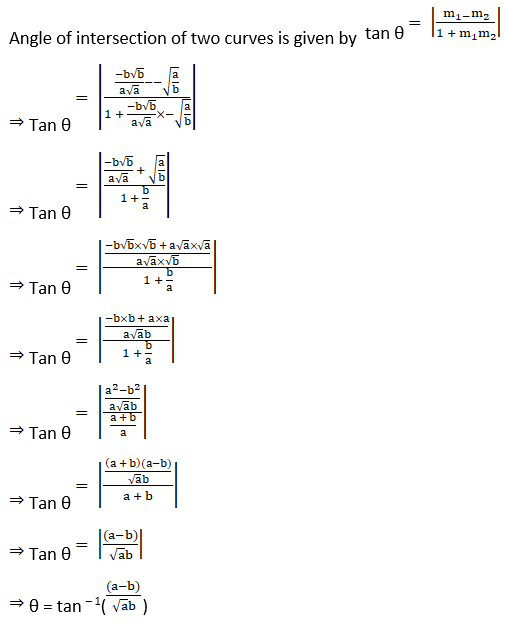
2. Show that the following set of curves intersect orthogonally:
(i) y = x3 and 6y = 7 – x2
Solution:
Given curves y = x3 … (1) and 6y = 7 – x2 … (2)
Solving (1) & (2), we get
⇒ 6y = 7 – x2
⇒ 6(x3) = 7 – x2
⇒ 6x3 + x2 – 7 = 0
Since f(x) = 6x3 + x2 – 7,
We have to find f(x) = 0, so that x is a factor of f(x).
When x = 1
f (1) = 6(1)3 + (1)2 – 7
f (1) = 6 + 1 – 7
f (1) = 0
Hence, x = 1 is a factor of f(x).
Substituting x = 1 in y = x3, we get
y = 13
y = 1
The point of intersection of two curves is (1, 1)
First curve y = x3
Differentiating above with respect to x,
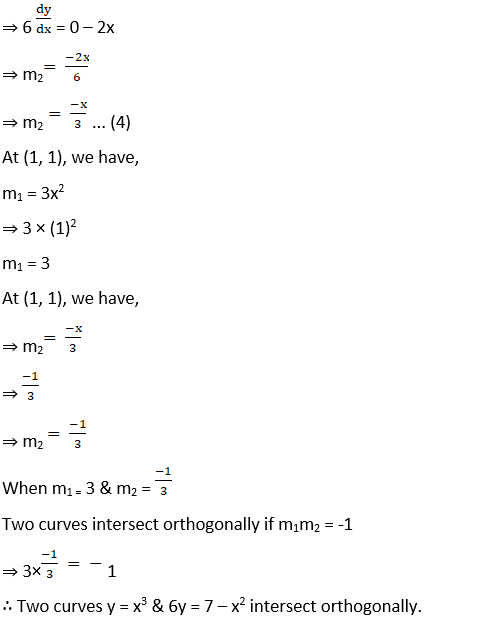

(ii) x3 – 3xy2 = – 2 and 3x2 y – y3 = 2
Solution:
Given curves x3 – 3xy2 = – 2 … (1) and 3x2y – y3 = 2 … (2)
Adding (1) & (2), we get
⇒ x3 – 3xy2 + 3x2y – y3 = – 2 + 2
⇒ x3 – 3xy2 + 3x2y – y3 = – 0
⇒ (x – y)3 = 0
⇒ (x – y) = 0
⇒ x = y
Substituting x = y on x3 – 3xy2 = – 2
⇒ x3 – 3 × x × x2 = – 2
⇒ x3 – 3x3 = – 2
⇒ – 2x3 = – 2
⇒ x3 = 1
⇒ x = 1
Since x = y
y = 1
The point of intersection of two curves is (1, 1)
First curve x3 – 3xy2 = – 2
Differentiating above with respect to x,
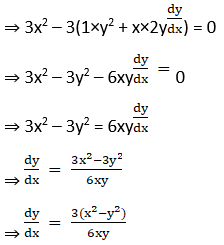
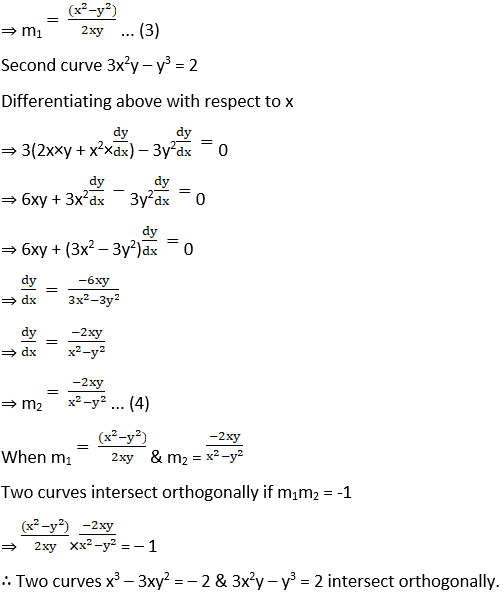
(iii) x2 + 4y2 = 8 and x2 – 2y2 = 4.
Solution:
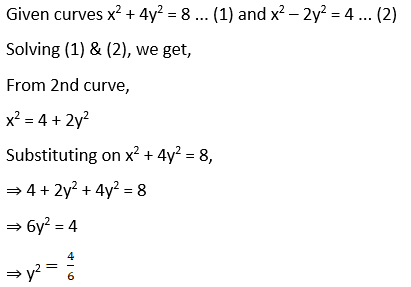
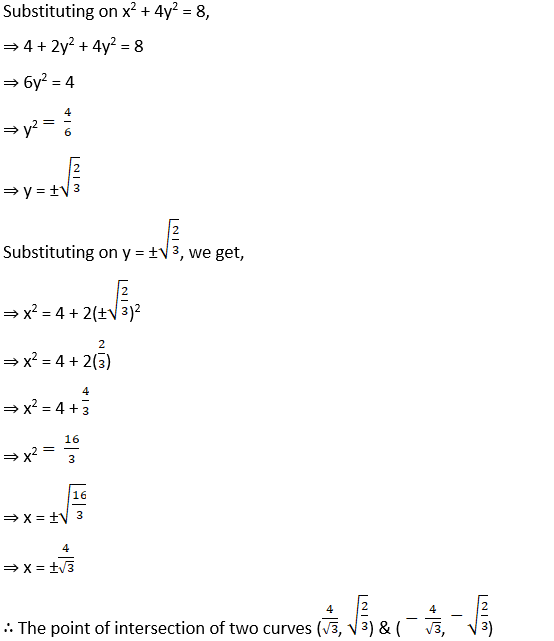
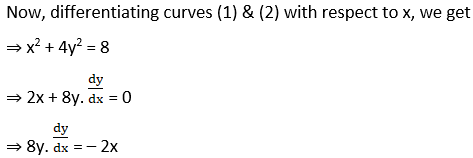
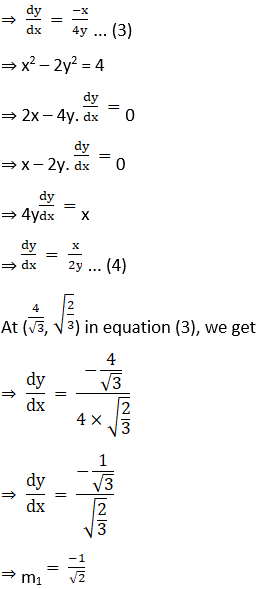
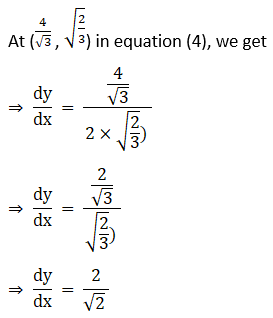
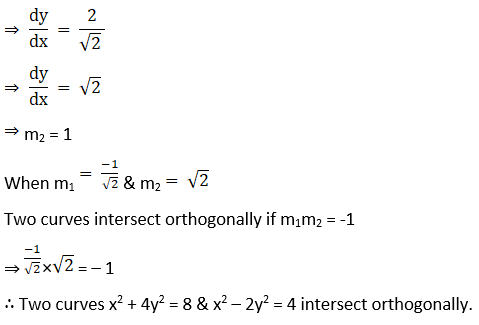
3. x2 = 4y and 4y + x2 = 8 at (2, 1)
Solution:
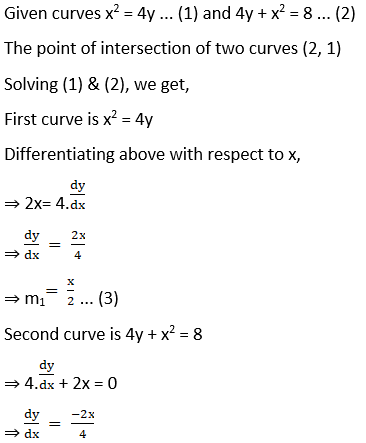
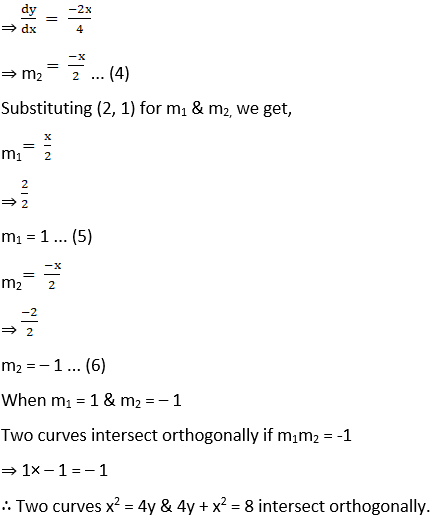
(ii) x2 = y and x3 + 6y = 7 at (1, 1)
Solution:
Given curves x2 = y … (1) and x3 + 6y = 7 … (2)
The point of intersection of two curves (1, 1)
Solving (1) & (2), we get,
First curve is x2 = y
Differentiating above with respect to x,
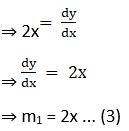
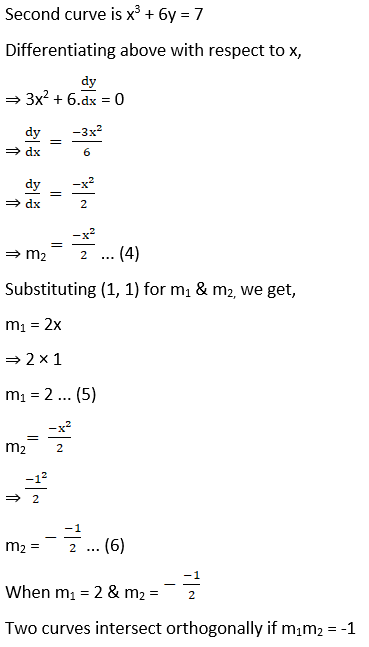

(iii) y2 = 8x and 2x2 + y2 = 10 at (1, 2√2)
Solution:
Given curves y2 = 8x … (1) and 2x2 + y2 = 10 … (2)
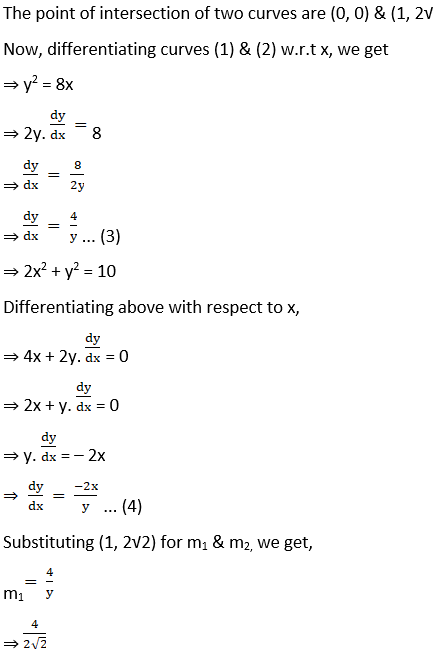
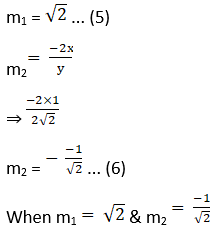
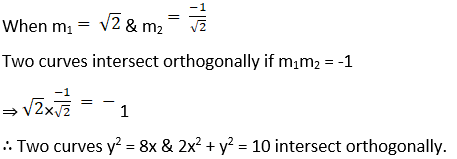
4. Show that the curves 4x = y2 and 4xy = k cut at right angles, if k2 = 512.
Solution:
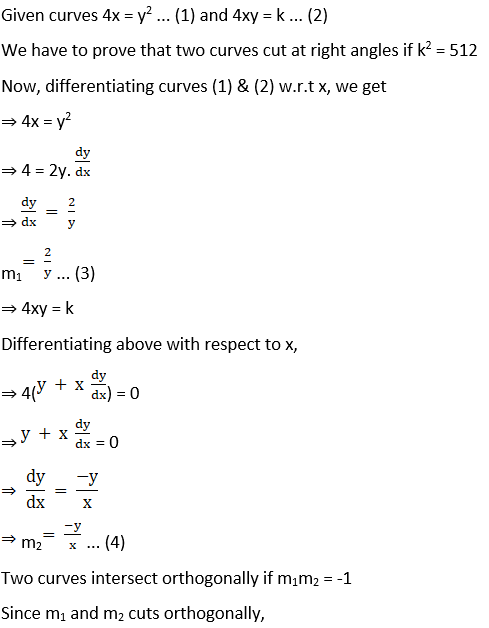
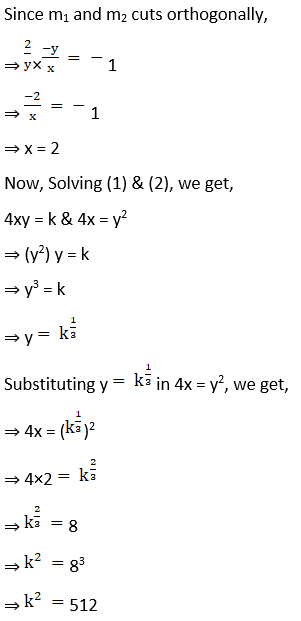
5. Show that the curves 2x = y2 and 2xy = k cut at right angles, if k2 = 8.
Solution:
Given curves 2x = y2 … (1) and 2xy = k … (2)
We have to prove that two curves cut at right angles if k2 = 8
Now, differentiating curves (1) & (2) with respect to x, we get
⇒ 2x = y2
